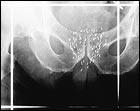

|
|
Highlights of this issue
Focus on BRCA mutations
Asthma symptoms in Canadian adults The prevalence of asthma is increasing in industrialized countries. Current understanding implicates both genetic and environmental factors in the cause of the disease. Jure Manfreda and colleagues used a standardized questionnaire from a recent European study to examine the variability in prevalence rates of asthma symptoms, attacks and medication use among 18 616 people aged 20–44 years at 6 Canadian sites: Vancouver, Winnipeg, Hamilton, Montreal, Halifax and Prince Edward Island. The reported prevalence rates of most asthma symptoms varied significantly between the sites; for example, the rate of wheezing varied from 21.9% to 30.4% for men and from 24.0% to 35.2% for women, and the rate of asthma attacks varied from 4.4% to 6.3% for men and from 5.2% to 9.5% for women. Use of asthma medication was reported by 4.0%–6.1% of men and 4.9%–9.7% of women. The variation is not explained by differences in smoking status, occupational exposure and place of birth. Premature labour: Home or hospital? Preterm labour occurs in about 10% of pregnancies and is the main cause of premature birth. In current practice, women initially admitted for control of preterm labour tend to remain in hospital until delivery. Céline Goulet and colleagues report on the results of a randomized clinical trial to compare home care with hospital care after initial treatment for preterm labour. They found no significant differences between the 2 groups in mean gestational age at delivery (37.52 weeks v. 37.50 weeks), mean birth weight (2974 g v. 3020 g), proportion of preterm births or mean duration of neonatal stay in hospital, intensive care unit or immediate care nursery. Mean initial and overall hospital stays were shorter in the home group than in the hospital group. Mental health in primary care
Brachytherapy for prostate cancer
 Brachytherapy (the permanent implantation of radioactive seeds) has recently re-emerged as a treatment option for localized prostate cancer. Despite the absence of data from randomized controlled trials, brachytherapy appeals to both urologists and patients as a minimally invasive alternative to radical prostatectomy and external beam radiotherapy. The Genitourinary Cancer Disease Site Group of the Cancer Care Ontario Practice Guidelines Initiative conducted a systematic overview of the literature to assess the role of brachytherapy in early prostate cancer. The authors conclude that it should be considered for selected patients: those with stage T1c or T2a tumours, a Gleason score of 6 or lower, a serum prostate-specific antigen level of 10 µg/L or less, no prior transurethral resection of the prostate and a prostate volume of less than 50 mL. In a related commentary Curtis Nickel summarizes the history of brachytherapy for prostate cancer and advises a degree of caution.
Brachytherapy (the permanent implantation of radioactive seeds) has recently re-emerged as a treatment option for localized prostate cancer. Despite the absence of data from randomized controlled trials, brachytherapy appeals to both urologists and patients as a minimally invasive alternative to radical prostatectomy and external beam radiotherapy. The Genitourinary Cancer Disease Site Group of the Cancer Care Ontario Practice Guidelines Initiative conducted a systematic overview of the literature to assess the role of brachytherapy in early prostate cancer. The authors conclude that it should be considered for selected patients: those with stage T1c or T2a tumours, a Gleason score of 6 or lower, a serum prostate-specific antigen level of 10 µg/L or less, no prior transurethral resection of the prostate and a prostate volume of less than 50 mL. In a related commentary Curtis Nickel summarizes the history of brachytherapy for prostate cancer and advises a degree of caution.
Copyright 2001 Canadian Medical Association or its licensors |